International Youth Work and the Quality Bonus
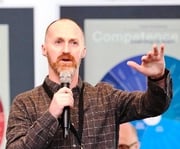 In March 2018, Léargas funded a small team of delegates to attend a SALTO Conference called 'The Quality Bonus' held in Mainz, Germany. The conference brought together stakeholders in youth worker education and training to further contribute to the development of quality youth work. It focused on systems and opportunities for youth workers by exploring topics related to the European Training Strategy (ETS).
In March 2018, Léargas funded a small team of delegates to attend a SALTO Conference called 'The Quality Bonus' held in Mainz, Germany. The conference brought together stakeholders in youth worker education and training to further contribute to the development of quality youth work. It focused on systems and opportunities for youth workers by exploring topics related to the European Training Strategy (ETS).
Dermot O’Brien has been involved in youth work in Ireland for more than 20 years. He is a freelance trainer, facilitator and consultant in national and international youth work, as well as a voluntary youth worker with Celtic Youth Bray, Be Well Bray and Phoenix Youth Project. In this post, Dermot outlines his experience of the conference.
Building capacity and quality in youth work
This was the first European Training Strategy (ETS) Conference that focused on exploring and discussing ideas and strategies for better capacity building and quality development, both within youth work and through enhanced education and training of youth workers. Far from a ‘one off’ event, this gathering of over 100 practitioners who are passionate about youth work sits comfortably in the flow of work associated with the ETS.
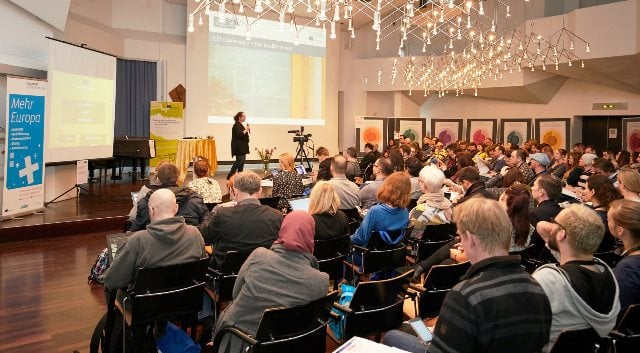 Over 100 delegates attended the conference
Over 100 delegates attended the conference
The ongoing attention and value placed on the development of youth workers continues to inspire ambitious activities and events like this. Each of these activities represents an authentic movement towards better quality, recognition and development of youth work and youth workers.
One Man, Three Hats
I was delighted to be selected to attend the Conference, and mindful of the numerous hats that I bring to the occasion. Hat number one is my ‘Youth Worker’ hat. Perhaps a little old, with some character, and frayed around the edges, but nevertheless it has some stories to tell which might just contribute to the conference. Hat number two is my ‘Trainer’ hat. Not as old as my youth worker hat, but it has some wear on it - twelve years or so. It's a wonderful hat that is a direct product of this European world of Youth Work. Over 90% of my development as a trainer has been supported by Léargas through the previous iterations of Erasmus+. So, I wear this hat with pride and I tip it often to those who have supported my journey as a trainer. Wearing this hat also gives me a responsibility to represent my colleagues within the ‘Trainer Pool’ of Léargas. My third and newest hat is the ‘Tutor’ hat. It's worn less often, but it has a fascinating story to tell because I wear it in my role as a tutor in Liberties College, teaching on the Youth and Community NFQ Level 5 course: yes, the non-formal within the formal!
A Five Star Conference
The Conference organisers in SALTO went all out with this one! There were keynote speakers to stimulate and challenge us; digital activities to help us connect and to capture our reactions throughout the event; and creative outlets for our reflections and insights.
The core element of the conference was on day two, when we were invited to consider a five-star menu of options by way of 36 different inputs, workshops and sessions delivered by over 25 different practitioners. Spoiled for choice is an understatement when you are looking at such a map of possibilities. Workshops in rooms spread throughout the whole venue invited us to exchange and explore youth worker education and training from so many different perspectives!
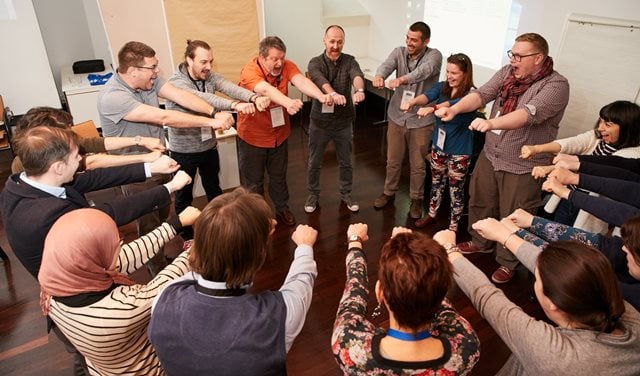 A 'whispering madzinga'!
A 'whispering madzinga'!
Four Themes
The four thematic areas that framed the conference were:
- Why youth worker education and training?
- What do we focus on in youth worker education and training?
- How do we do youth worker education and training?
- The world around youth worker education
It would be fair to say that youth work looks different in every country across Europe. But it would also be fair to say that the values and principles of youth work have more in common across the continent than not.
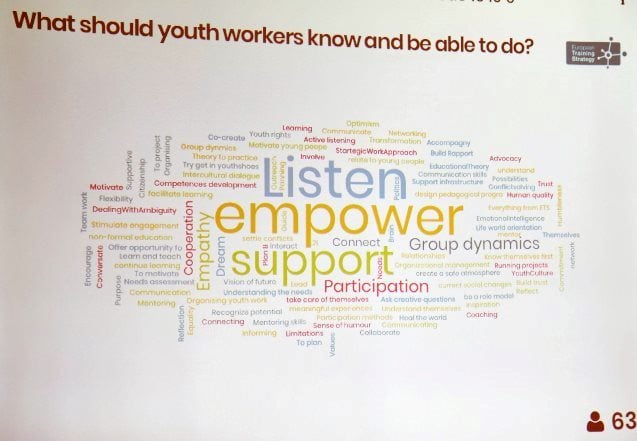
Embedded in every element of these thematic areas, and featuring across all of the inputs in one way or another throughout the conference, was the newly developed ‘Competence Model for Youth Workers to Work Internationally’. The amount of work that has gone into the development of this framework for me merits the type and scale of the conference we had in Mainz. The contribution that this model has the potential to make in the youth work landscape represents a positive and powerful force for the quality development of youth workers, regardless of their location or status. (You can find out more about the Competence Model, and a link to it, at the end of this post).
Two Inputs
I had the privilege to deliver two inputs at the conference. One was about the barriers within the formal education system for those studying youth work, and the other was about well-being in youth worker education and training. My main challenge was to balance the energy between contributing to the conversations as a facilitator and as a participant. I genuinely value both roles and consider it a gift to have an opportunity to dance in both sets of shoes!
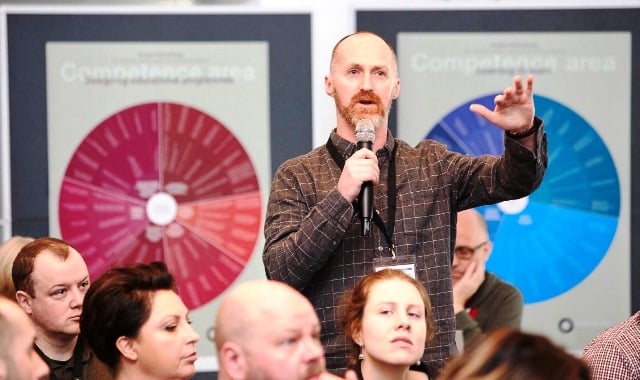
Digital Dimension
A wonderful feature of the conference was the digital dimension. It reminded us that in modern times youth work, of all endeavours, should be at the forefront of innovative conferencing! Of course there was live streaming, the continuously updated social media wall, the photographer, the graphic artist and so on, but the stand-out features for me were the Actionbound app which gave us some tasks before and during the event (for Irish youth workers it would be like the ultimate treasure hunt, but with a phone!). I liked that the event's programme was shared in an online space where participants could make contributions or notes about the input they attended, all of which would be included in the report. I enjoyed the interactive engagement during keynotes using the Mentimeter website. The inclusion of the digital dimension certainly enhanced my experience of the conference.
What's next?
In terms of takeaway from the conference I would say that first and foremost Léargas sent a brilliant and diverse team of delegates: myself, Aiste Slajute, Hilary Tierney and Leo Gilmartin. The significance of this lies in the different areas available to each of us for giving life to the ETS and the Competence Model back in the Irish context. This will not happen by accident nor will it flourish of its own accord. It is our intention to work within our own spaces and, with the ongoing support of Léargas, to map the potential of the ETS and its component parts and to consider how that mapping might influence the development of a strategy that will give life to the ETS in Ireland.
Find out more!
The European Training Strategy encourages decision makers, experts and practitioners to cooperate in improving the quality of youth work and its recognition. The ETS aims to establish a peer-learning process so that stakeholders can exchange concepts and good practice. Since knowledge about the effects of capacity building on quality youth work is limited, the ETS encourages the use of online platforms and research studies to gather knowledge and raise awareness. Based on these measures, the goal is to produce common guidelines and a set of quality criteria for capacity building in the field of youth on national as well as European levels. One of the ways to meet this goal will be to provide orientation and guidance to those who train youth workers. Based on the Competence Model for Trainers, the ETS aims to develop a modular system to train trainers within the context of Erasmus+. For more information, visit this SALTO page on the ETS.
The Competence Model for Youth Workers to Work Internationally defines quality criteria and indicators (in and for youth work), as highlighted in the Council conclusions on quality of youth work (2010) and in the final declaration of the 2nd European Youth Work Convention (2015): ‘[…] there needs to be a core framework of quality standards for youth work responsive to national contexts, including competence models for youth workers, and accreditation systems for prior experience and learning […]’. Developing specific key competences has become increasingly important for youth workers to work internationally. This development is now showing up on the agenda of the European institutions. Providers of non-formal learning, training and education--as well as Erasmus+ Youth in Action--are paying closer attention to these competences. Being able to identify and describe youth worker competences better will help improve the image and recognition of youth workers in society. In addition the strategies, tools and educational materials included in the document will make capacity-building more effective. You can download a copy of the Model as a PDF here.
Dermot O'Brien has written for our blog Insights before on Life and youth work through an international lens and Erasmus+ KA3: Youth Empowerment for Political Participation.
Dr Hilary Tierney spoke at our Time to Move Conference in 2016 on the benefits of youth mobility.
Image credits: Marcus Gloger; Léargas (Soundcloud thumbnail).
We welcome contributions to ‘Insights’ at comms@leargas.ie.
